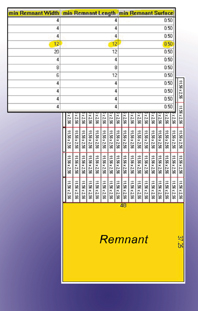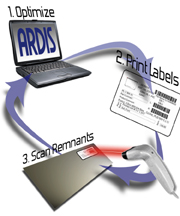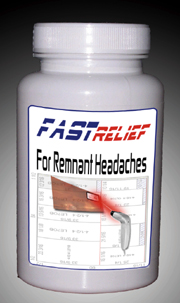|
Integrating Optimization, Inventory and Scrap Management
If there is one persistently frustrating aspect of cutting
plastic sheets, it is figuring out what to do with the
 remnants. How do you decide what remnant size is
worth keeping? How do you organize your remnant inventory?
How in the world are you going to find these pieces
again when you need them?
remnants. How do you decide what remnant size is
worth keeping? How do you organize your remnant inventory?
How in the world are you going to find these pieces
again when you need them?
In the struggle to answer these questions another
important aspect of many cutting operations is often
ignored: optimization. Saving and logging remnant pieces
is a great way to improve your bottom line, but it is a “post
process” method of increasing efficiency and only works if
the remnants can be properly logged and recovered when
needed.
Optimization increases efficiency before the first sheet
is even cut. In its most basic form, an optimizer calculates
how to maximize material yield based on your raw material
sizes and your cut list parts. Most modern optimizers
also take advantage of machine parameters such as stack
(or book) height and can link to computerized CNC equipment.
Some can be set to optimize factors besides material
yield, such as material cost, machine operating time
and labor costs.
So which aspect deserves more
focus? Using an optimizer in its yield
mode increases yield and reduces
the number of remnants. That
means the remnants do not pile up
as quickly and there is more time to
effectively manage a smaller scrap
inventory, something the optimizer
can help you with as well.
An optimizer with a scrap management
feature makes it very easy to
keep track of remnant inventory
because it can keep track of all part
list data throughout the entire manufacturing
process. You use the optimizer
to get the best fit for your
parts and the program will detect
remnants for you before you even
cut the first sheet. Recovering the
remnants can be done within the
same program using customizable
barcode labels. Since all the part data is in the optimization
software it is a snap to print a label for the remnants
and immediately add them to the available material or
put them in storage.
Another benefit of optimization and scrap management
with barcoding is that a well designed system
requires no manual data input. If you use an order entry
software or cut list software to generate your parts list
you will never have to type a thing into a spreadsheet.
The optimizer handles all of the information imported
from the order entry and can put any amount of that
 information onto a label.
information onto a label.
Recovering the remnants can be done
with a barcode scanner, which immediately
returns all of the
information about a
remnant as soon
as the label is
scanned.
So how
does this
improve the
efficiency of a
shop? A lot of
companies
spend a lot of
time measuring
and logging
remnants
that
they will never use again because it is such a hassle to dig
them up. If you have software that is taking care of the
measurement beforehand and printing labels to help you
track down the remnants when you need them, you are
going to cut a lot of fat from your labor costs.
Using material in the most efficient way possible is a
goal for any shop trying to make a profit. Given the
lengths that most shops go through to squeeze the most
out of their raw material,
it is strange that so
many have ignored optimization.
It seems contradictory
that many see
optimizing as a waste of
money when they have
thousands of remnants
sitting around that can
be worth hundreds of
dollars each.
In reality inventory
management and optimization
are very closely
related. Remnants are
like any other raw material;
the difference is that
there is no immediate
use for the remnant
 when you do the cutting.
when you do the cutting.
All of this makes sense when you consider that the remnant
is a natural result of the parts you have to cut and
the raw material sizes you have available, the core data
that the optimizer uses to make its calculations. It figures
out what material sizes will be left over before hand and a
simple calculation bridges the gap between waste piece
and re-usable part. When you consider this, combining the
two systems into one seems like a logical step and ultimately
may prove to be the surest cure for remnant
headaches.
Written by David E. Talbot, Product Manager for
Eurosoft, Inc., developers of the ARDIS Cutting Optimizer,
a sheet optimization program that produces high yield
combined with an enormous variety of customization
options such as reusable scrap. Eurosoft is actively
involved in integrating their Ardis software with existing
order entry and saw equipment. Their activities extend
from the individual plastic distributor with a single user
license to large network systems with integration to company
wide inventory control and order entry systems.
They offer training and a comprehensive technical support
service.
For more information, contact Eurosoft, Inc., 1628
Old Apex Road, Cary, NC 27513, 919-468-3003, Fax:
919-468-6374, E-mail: david@eurosoftinc.com, Web:
www.eurosoftinc.com.
|